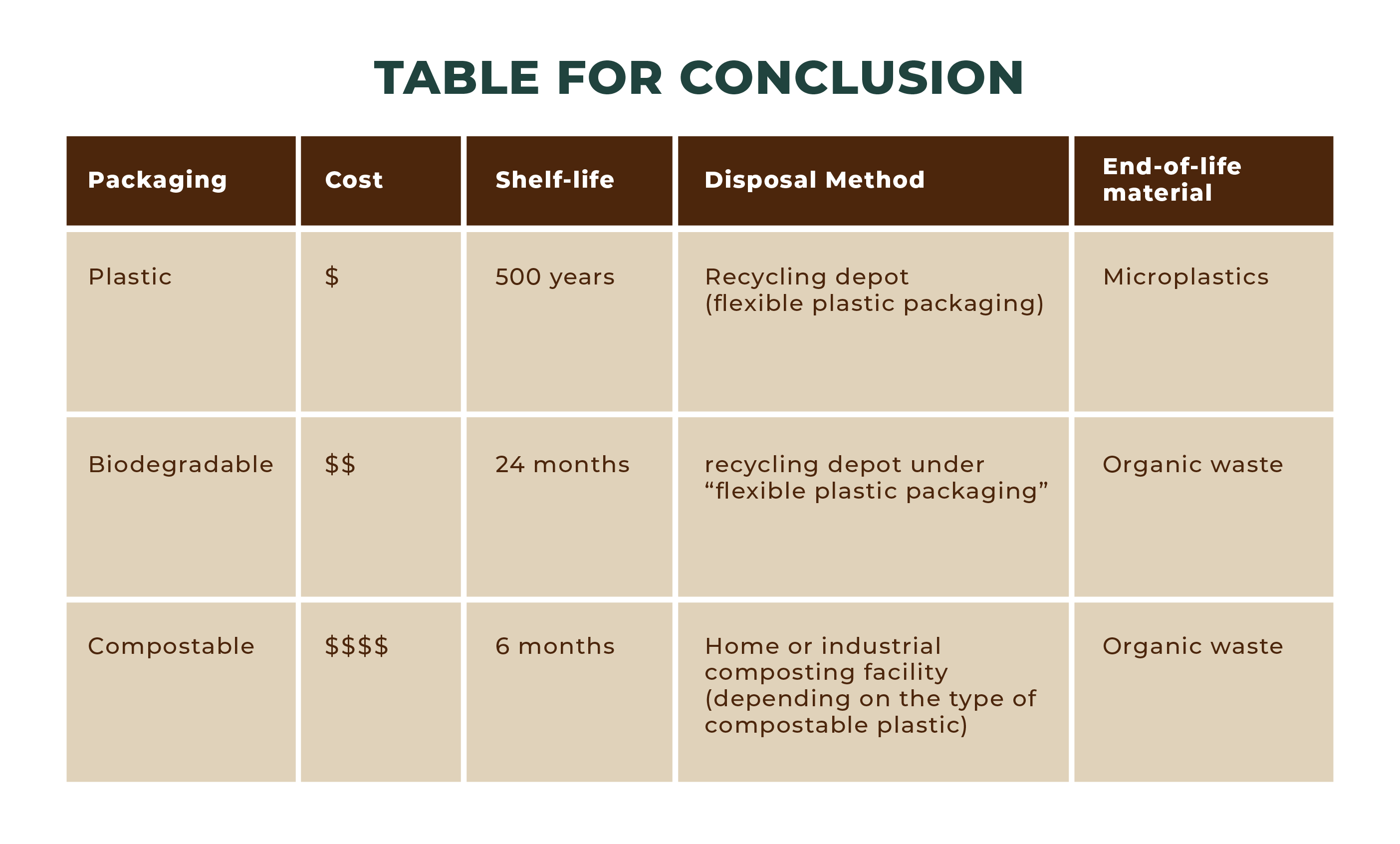As e-commerce continues to grow, more and more small business owners are looking for ways to reduce their environmental impact. However, finding the right eco-friendly packaging options can be a challenge. While compostable, biodegradable, and other sustainable options are becoming more widely available, not all of them are an ideal fit for small e-commerce shops.
In this article, we'll take a closer look at the pros and cons of different eco-friendly packaging options, and explore the factors that small business owners should consider when making their choices. From cost and design to disposal and customer preferences, we'll help you navigate the world of sustainable packaging and find the options that are best suited for your business and your customers.
Learn more about Sustainable & Eco-Friendly Packaging here
Plastic Packaging
Plastic packaging is a common type of packaging used in e-commerce, particularly for products that require flexibility and protection. This type of packaging is popular among small e-commerce businesses due to its cost-effectiveness, lightweight, and durability. Some examples of flexible plastic packaging include:

These types of packaging are lightweight and can be easily customized with a company's branding, making them an attractive option for small e-commerce businesses looking to make a good impression on their customers.
The issues with plastic packaging
However, plastic packaging also has its downsides, particularly in terms of its impact on the environment. Although they are 100% recyclable, only 6% end up being recycled (rePurpose offers an explanation here).
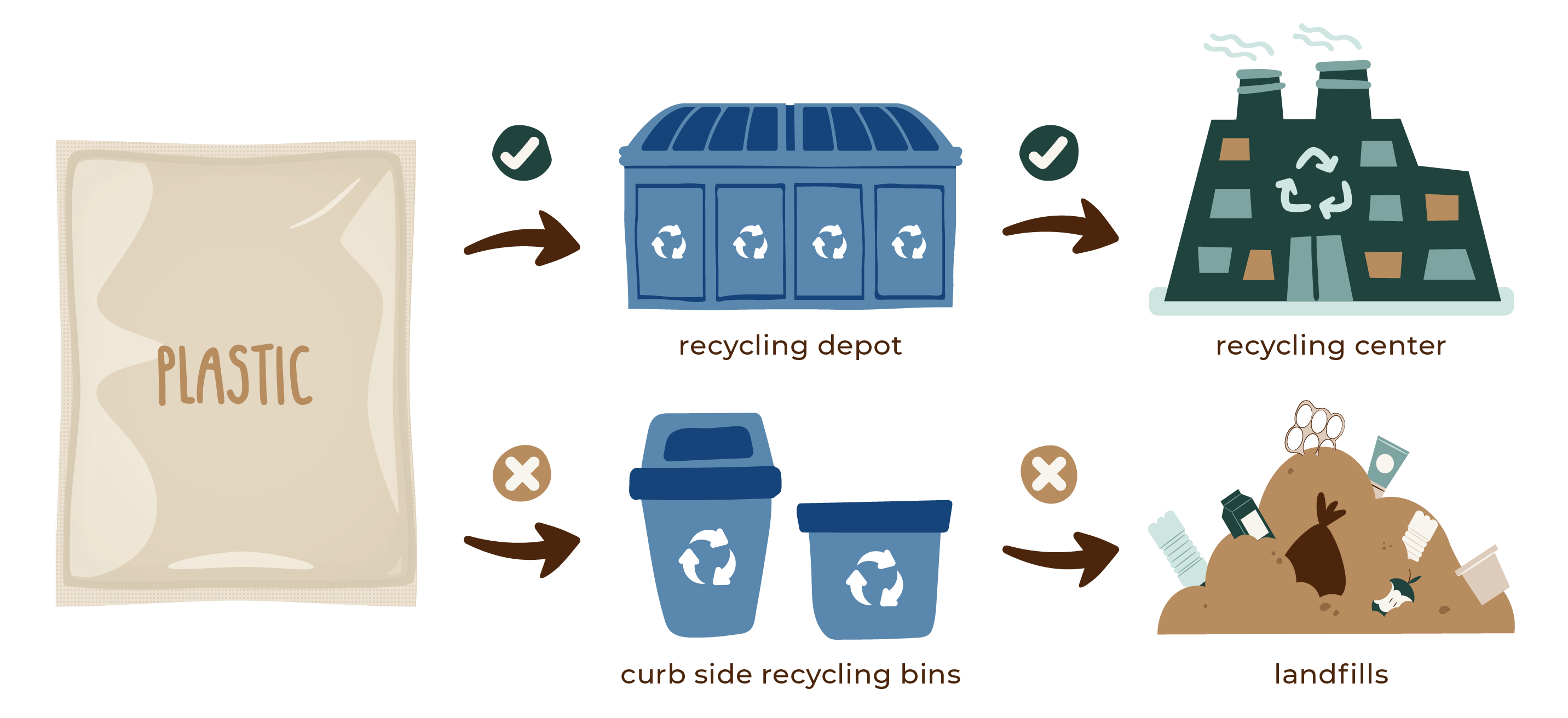
One of the main reasons for this is that flexible plastic packaging like poly mailers and plastic shipping bags (also known as “flexible packaging”) are not curbside recyclable and need to be brought to a local recycling depot.
This can make it difficult for some people to recycle their plastic packaging, which leads to it being incorrectly disposed of in the trash. Additionally, some people may not be aware that these items are not recyclable and may dispose of them with other organic waste, which would all end up in landfills.
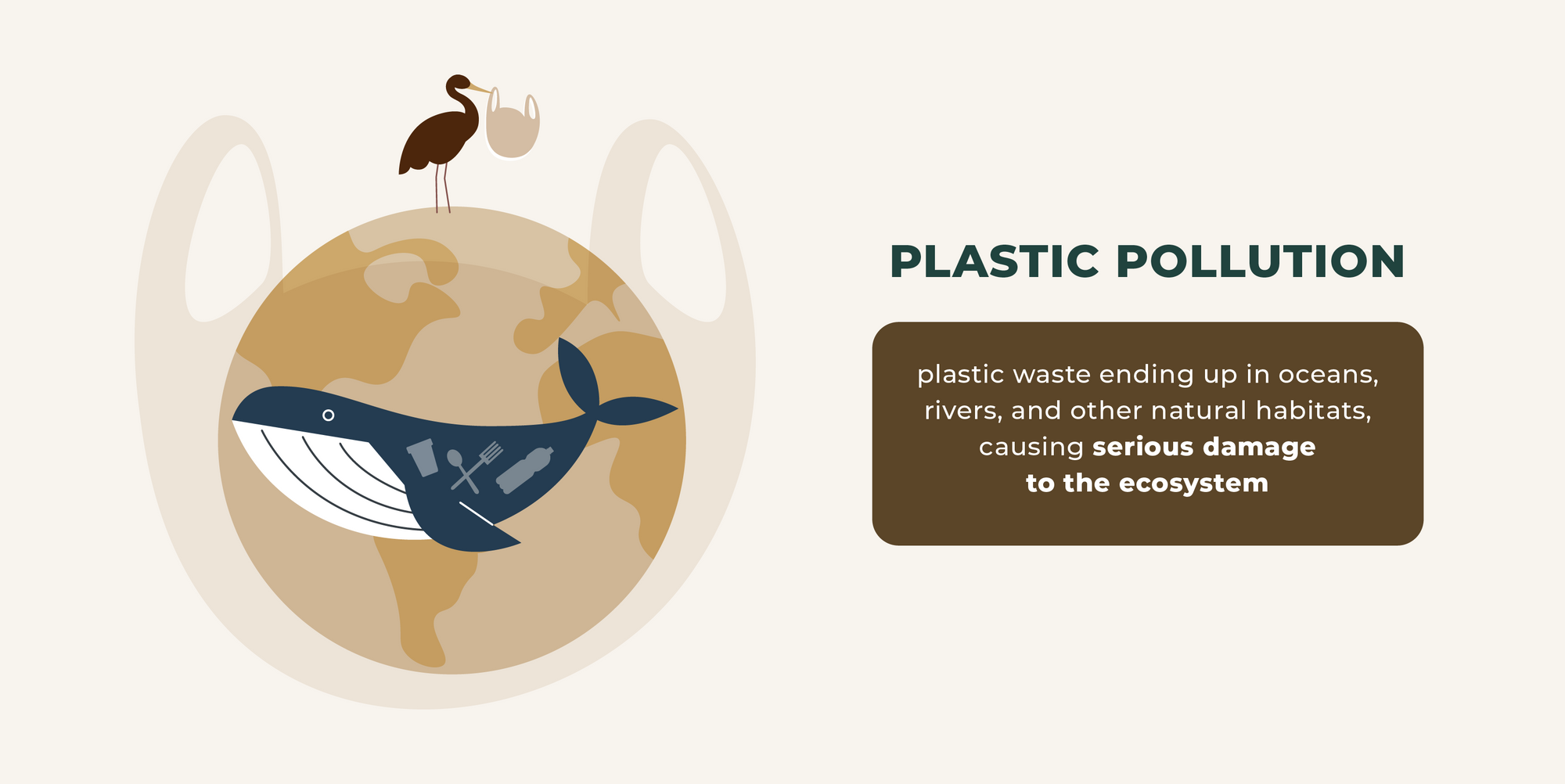
Overall, while plastic packaging may be among the most cost-effective and practical options out there, it certainly contributes to the growing plastic pollution crisis, with plastic waste ending up in oceans, rivers, and other natural habitats, causing serious damage to the ecosystem.
Compostable Packaging
Compostable packaging is created by combining natural materials such as plant-based and starch with a binding agent. These materials are designed to break down quickly in a composting environment (up to 180 days).
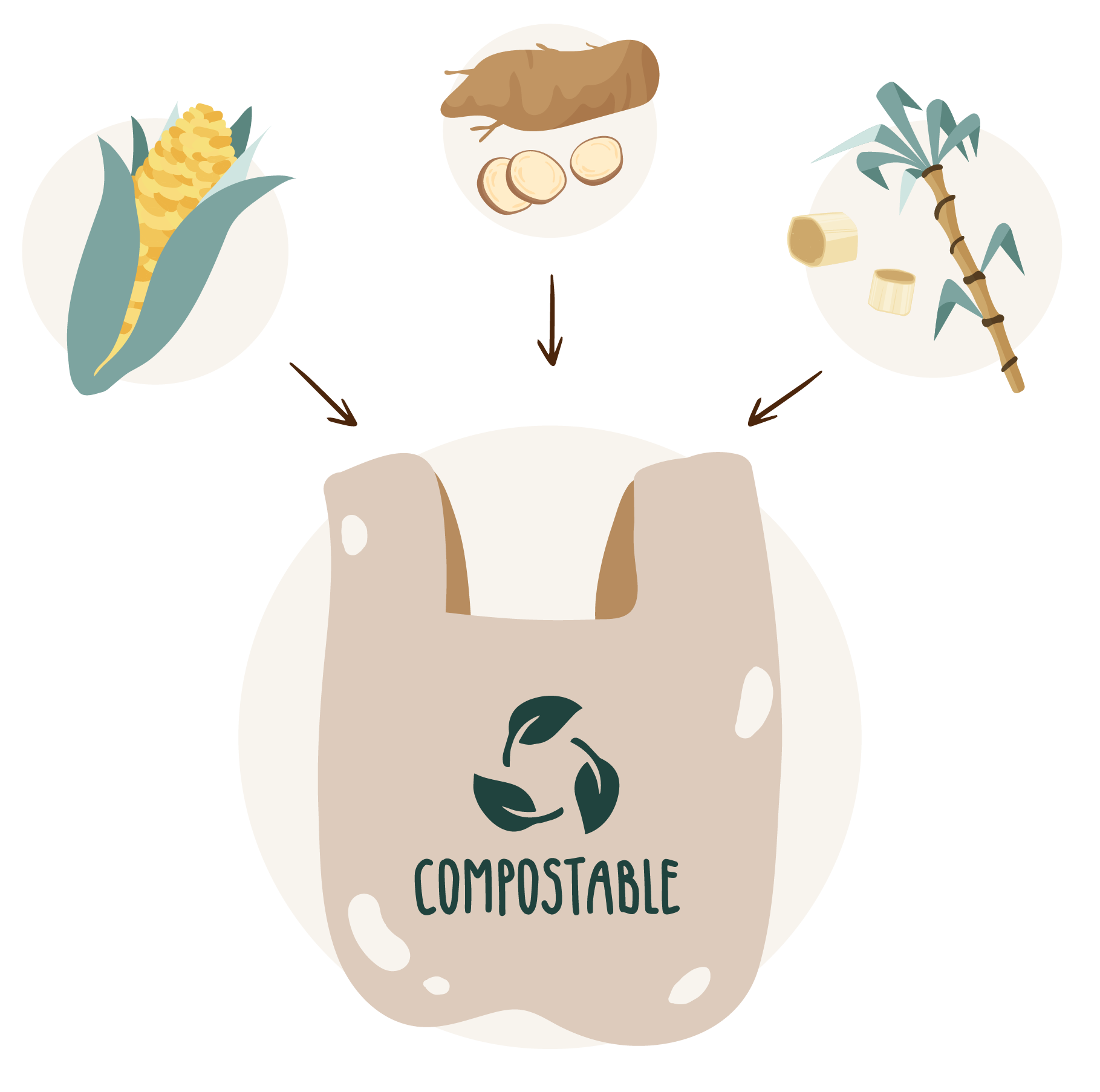
Industrial compostable plastics vs home compostable plastics
It is important to understand that there are 2 types of compostable plastics, sorted by the way they are disposed of: Industrial compostable plastics and home compostable plastics.
Industrial compostable plastics require a high temperature & humidity environment, along with the presence of oxygen for the plastics to break down.
Home compostable plastics have lower temperature & humidity requirements compared to their industrial counterpart, but they still need oxygen for the breakdown process to work (you will see a common theme where oxygen plays a key role in breaking down these plastics, whether it is biodegradable or compostable).
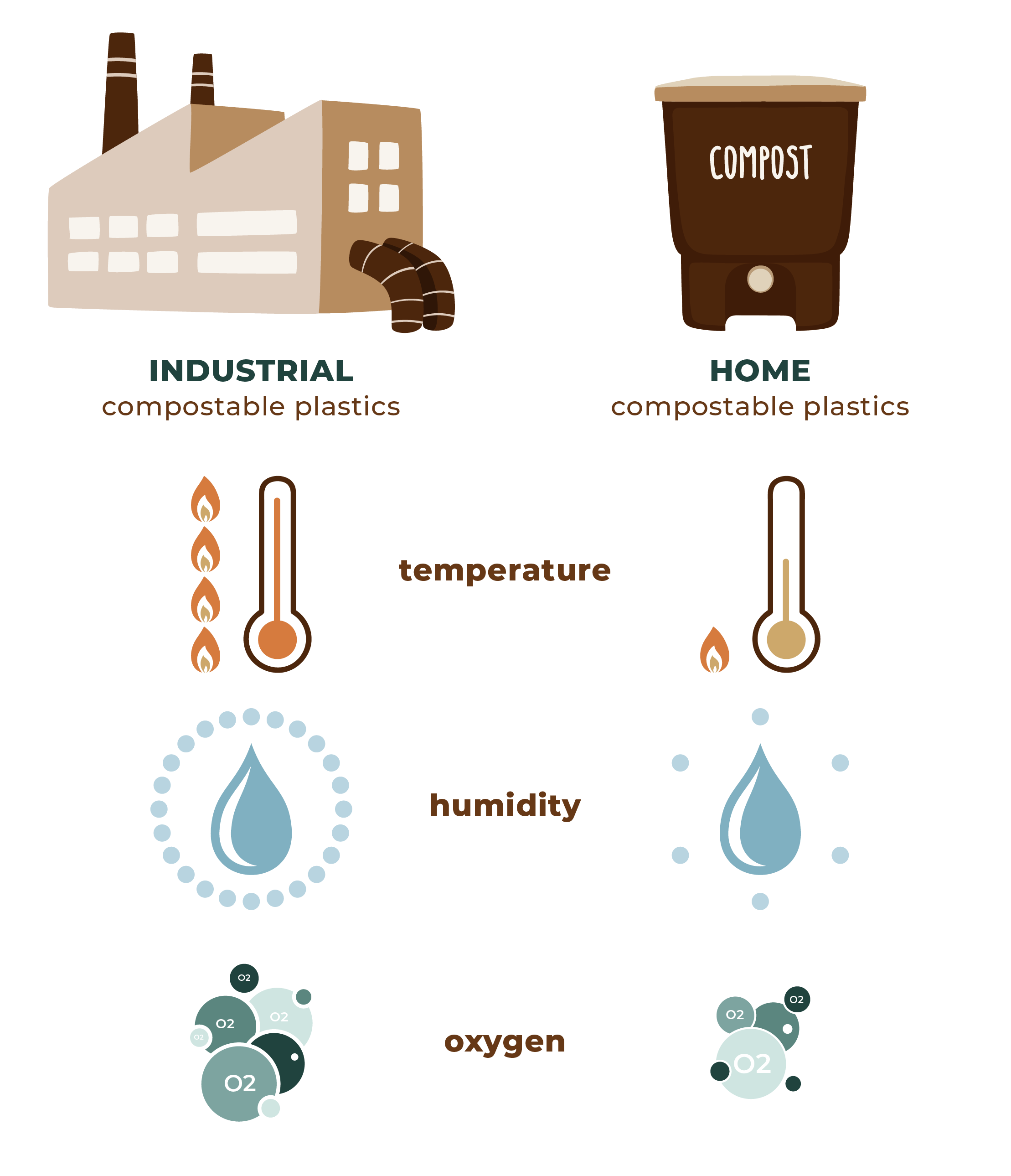
A majority of compostable plastics are only industrial compostable, so you need to take them to an industrial compost site. And that is where it gets tricky.
The issues with compostable packaging
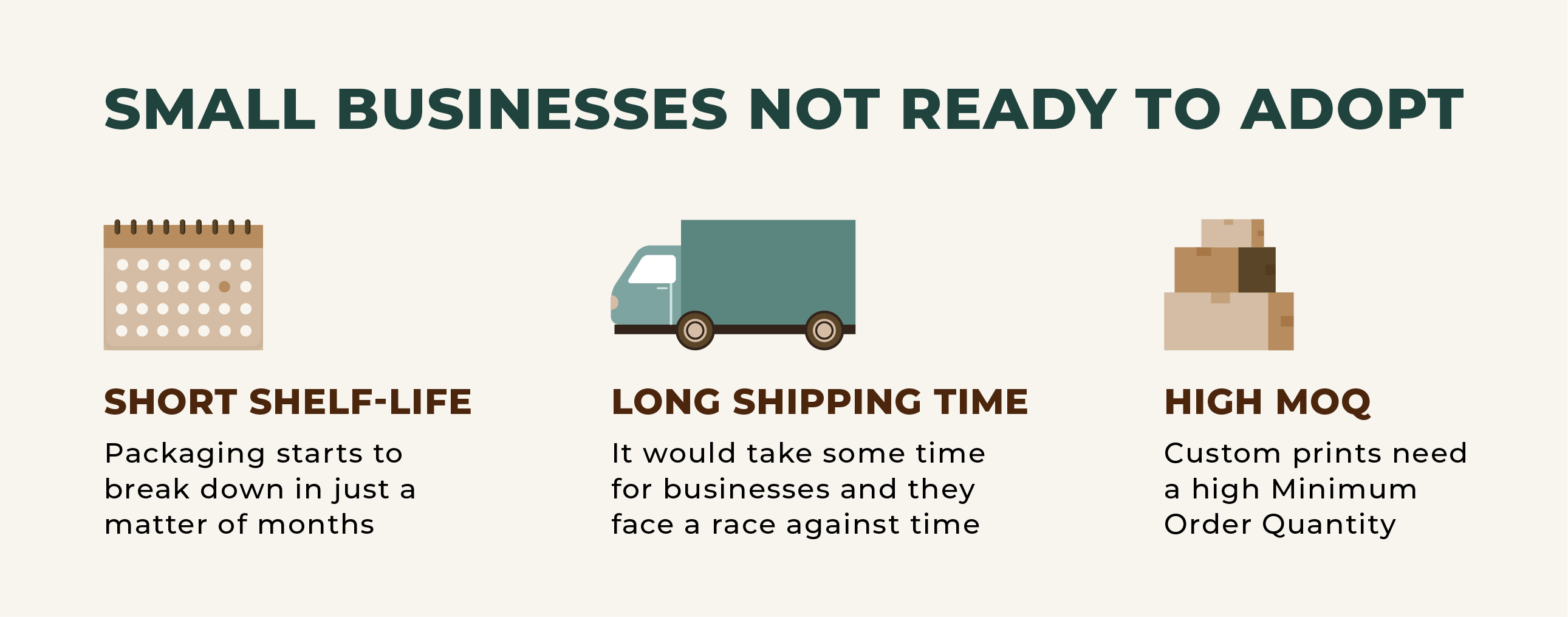
As sexy as it is on paper, compostable packaging also has its challenges. For example, it's often more expensive than traditional packaging options, which can be a barrier for some small e-commerce businesses.
On top of that, the relatively short shelf-life and typically long shipping time is a concern for business owners, as the compostable packaging cannot retain its strength after a few months. This creates a dilemma when they want to order custom prints, and are required to meet a high Minimum Order Quantity (MOQ). It would take some time for the business to use up those packaging, and they face a race against time to do that while the packaging starts to break down in just a matter of months.
Is composting really that easy?
The short answer is: yes and no - It is relatively easy to do it, but not everyone is onboard with the idea.
While you can easily find a local recycling center nowadays in most developed countries that accept flexible plastic packaging and even biodegradable packaging, not all communities have access to commercial composting facilities, meaning that compostable packaging may end up in landfills where they would not break down properly. On top of that, compostable packaging that holds food items, if not washed properly, may contaminate other items and affect the entire process.
Here is another common misconception: Compostable plastics can be thrown into the trash since they would just break down like other organic waste.
This, in short, is incorrect. Just because the bags are compostable does not mean that they can be thrown together with common waste. This is because those general waste will end up in landfills, where there they all get compressed so tightly there is very little (if any) oxygen present, and a lack of oxygen prevents the biodegradation process to take place.
Another problem with home compostable plastic waste is that what companies say you can do vs what you should do can be quite different. For example: you often hear companies selling compostable plastic packaging say that the bags are home compostable so you can bury them in your back garden.
Here’s the thing: Yes you can bury the compostable plastic bags underground, and yes they will breakdown within 6 months. But is it practical to do so? Not really.
Burying the plastic bags in your garden can block the water and nutrition supply to your nearby plants. Moreover, they would still take months to breakdown, so imagine putting 10-20 bags in your back garden and they would just sit there for up to 6 months. Having said that, you can still do this properly by putting them into a compost bin, along with other organic waste.
Other problems
Further reading into the process of producing compostable plastics narrows the scope even more:
Resource intensive: The common materials used to make the plastics such as sugarcane, corn, cereal starch, oil crops, are often extremely resource-intensive crops. That translates to an extensive amount of water fertilizers, pesticides being used, along with the chemicals needed for process of converting them into compostable plastics.
According to a study from the University of Pittsburgh, the usage of those resources and chemicals during the creation of bioplastics led to higher pollution levels compared to traditional plastics.
In my opinion, it’s about managing expectations and understanding where people are at in their journeys towards sustainability: A lot of businesses selling eco-friendly packaging supplies (ourselves included) at times would assume that people understand all there is about sustainability, and the different types of materials.
However, most of us struggle to even understand the differences between biodegradable vs compostable, or that home composting is not just burying things into the soil in your garden.
Biodegradable Packaging
The term “biodegradable” often refers to the process in which plastic waste would breakdown. How quickly, and under which condition would depend on the type of materials we are talking about. That is one of the reasons why there have been a lot of confusion around this term.
Nowadays, when people talk about biodegradable plastics, they usually refer to oxo biodegradable plastics. Essentially, they are made by adding the d2w agent into the conventional materials that are used to make plastics.
When they are at the end of their life cycle, the plastics will start to break down (again, where oxygen is present) until there are just water, carbon dioxide and biomass left. The process typically completes within 24 months. The main benefits of biodegradable plastics for packaging are:

1. They can be recycled just like conventional plastics at recycling centers, under “flexible packaging”.
2. In case they escape the recycling process and end up in nature, they would breakdown at a much faster rate than conventional plastics.
3. The “shelf-life” of biodegradable packaging is a lot longer than compostable packaging, making them a more ideal solution when you factor in the time it takes, from the moment they were created to the last moment of their useful life.
The issues with biodegradable packaging
Just like with any other materials, biodegradable plastics also have their drawbacks. They are not compostable, and people claim that they need specific conditions for the degradation process to take place (similar to compostable, where they need a certain level of humidity, temperature, etc.,).
Many also argue that since they are made using conventional plastics, they cannot breakdown further beyond the microplastic state. However, there have been multiple studies that proved otherwise. The d2w biodegradable plastics have been tested and evaluated by Intertek (one of the biggest inspection companies in the world) in their life cycle assessment.
Similarly, the French government funded Oxomar to do a three-year study at the on plastics in the maritime environment. The study came to the conclusion that plastic produced using d2w technology will biodegrade in the marine environment much more quickly than conventional plastic. A more comprehensive list of tests and reports can be found here.
The biggest issue with biodegradable plastics is that people claim they do not breakdown within the 24 month period that was claimed, and that would be highly misleading to the customers (the business owners who buy these packaging) as well as the end consumers.
As a business that sells packaging supplies, I have decided to go down the rabbit hole and learn as much as possible about this. I also leveraged our position as the client and potential client of the packaging manufactures to allow us to get further unique insights on what goes on behind the scene, and why certain things are made the way they are.
From what I have learned, both from the materials published and from my experienced working with multiple manufacturers who produces both biodegradable and compostable packaging, there are two main reasons why some biodegradable plastics take longer than others to breakdown:
The ideal environment required to breakdown
Similar to compostable plastics, their biodegradable counterpart need the humidity, temperature along with the presence of oxygen, among other things, to reach a certain level to start the degradation process.
For that reason, a biodegradable bag that is buried under the sand at the sea vs buried in your garden vs one that is stuck to a tree branch in open air would break down at different times. However, typically this should not vary too much, unless one of the required component is seriously absent, such as oxygen (in which case, compostable plastics would also fail to breakdown)
The amount of d2w in the batch
This is without doubt the most important factor that decides how long it will take for the biodegradable plastics to breakdown. It is also straightforward: The more d2w additive is added, the quicker it takes for the plastics to breakdown at the end of their useful life.
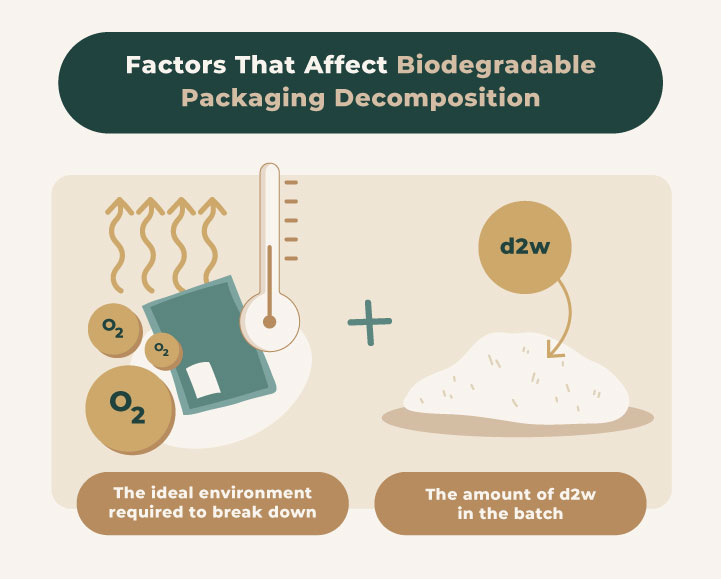
The average percentage required for the degradation process to complete within 24 months is 3%.
Over the last 2 years, we have discussed, run multiple sample tests and met many different packaging manufacturers. We have learned that because of the umbrella definition of “bio degradable plastics”, and that it is not currently a regulated term, any manufacturer can add d2w and claim it to be biodegradable, doesn’t matter the actual percentage of additive.
We have met with manufacturers who only use 1% of additive, and claimed it to have little to no difference to the breakdown speed. However, when pressed about the specific methods they carried out to test, and the length of the tests, the answers suddenly became vague.
One of them explained that since there is no difference between the range 1% to 10%, they went with 1% because the prints would come out better, as there “less grains and white spots on the print surface”. In other words, they would use just enough additive to have the label “biodegradable plastics”, and prefer visuals quality over the environmental impact.
On our part, we ended up not working with them, despite having paid for the molds and got the samples done already.
Factors to Consider When Adopting “The Greener Alternatives”
When it comes to choosing the right packaging for your ecommerce business, there are a few key factors to consider. Not only do you have to think about the financial and logistical aspects of your business, but you also have to consider the impact of your packaging on both the environment and your customers.
From the Business Owner's Perspective
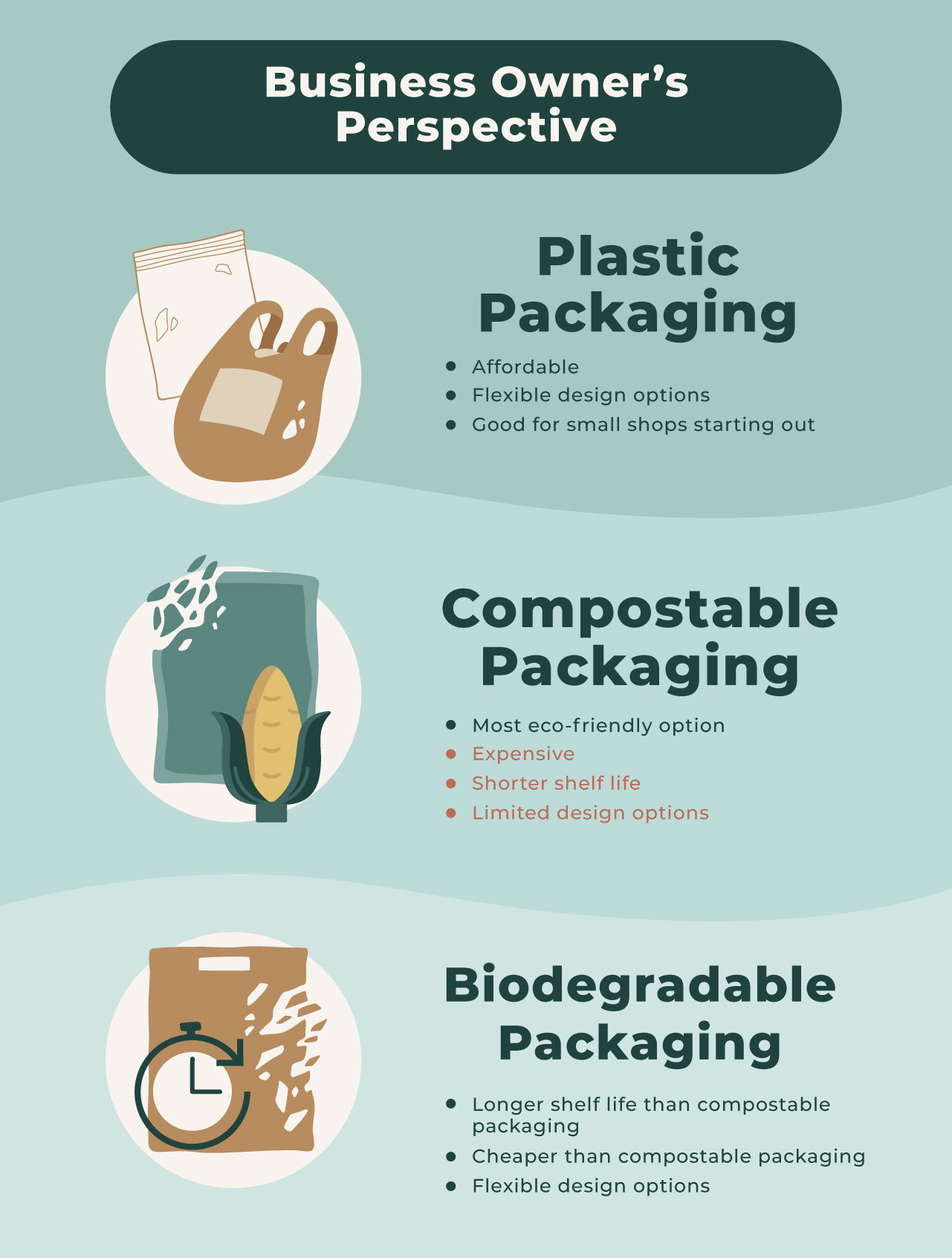
-
Plastic Packaging: Plastic packaging is often the cheapest and most appealing option for small shop owners who are just starting out on a budget. However, as businesses grow and prioritize sustainability, they may start to consider other options.
-
Compostable Packaging: Compostable packaging is a great option for businesses that prioritize sustainability, but it comes with its own set of challenges. These materials are more expensive and have a shorter shelf-life than traditional plastics. Additionally, you can only create simple (often single-color) designs due to the properties of the compostable material.
- Biodegradable Packaging: Biodegradable packaging is the middle ground between plastic and compostable packaging. It has a longer shelf-life and is cheaper than compostable packaging, while still being more sustainable than traditional plastics. Additionally, it allows for more elaborate designs.
From the manufacturer’s perspective
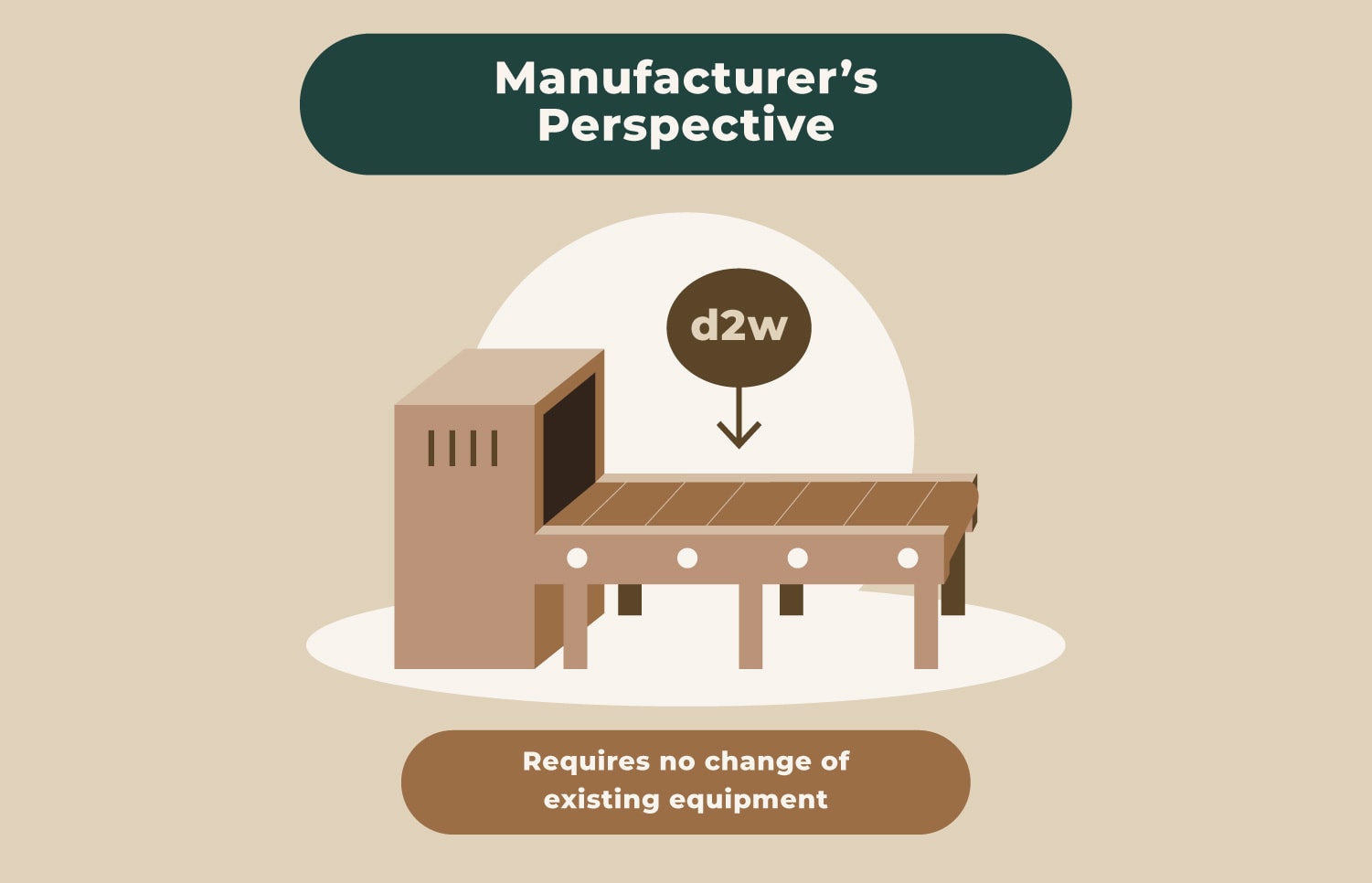
On the point of biodegradable plastics, from a manufacturer's perspective, it is a more easily adoptable option as it requires no change in equipment or machinery (only the cost of adding the d2w additives into the masterbatch). This added cost to produce biodegradable packaging can easily be passed on to customers.
From the End Consumer's Perspective
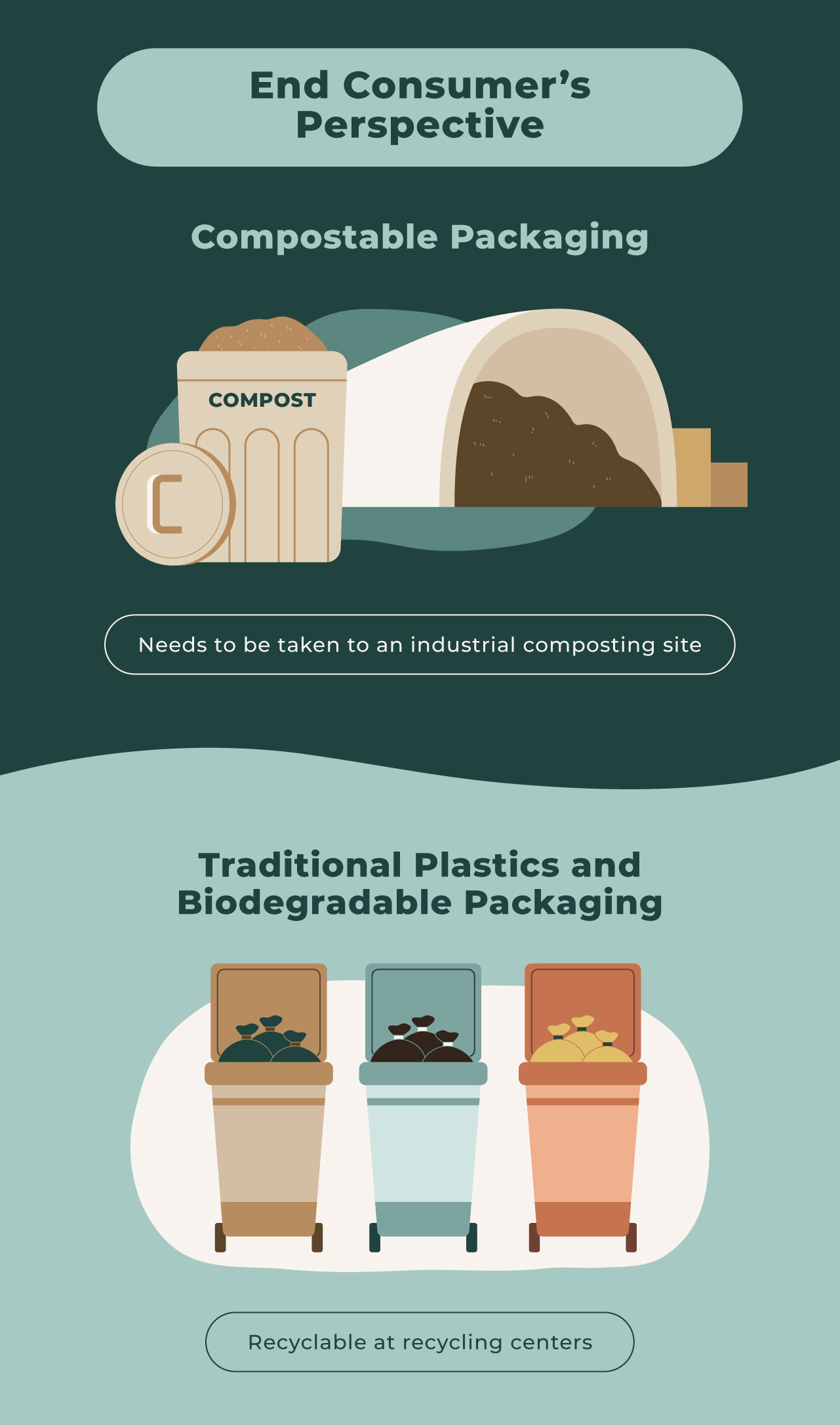
-
Sustainability Efforts: As consumers become more environmentally conscious, they are more likely to support brands that make an effort to be sustainable and environmentally friendly.
- Disposal: Consumers also consider how they will have to dispose of the packaging. For example, compostable mailers may require them to bring the materials to an industrial compost site, which may not be available everywhere. Biodegradable or plastic packaging, on the other hand, can be disposed of at local recycling centers.
Ultimately, it's all about understanding your audience and what they are looking for in a packaging solution. If they are all for sustainability and willing to go the extra mile to dispose of packaging waste properly, then compostable packaging would be the best option. However, if they are more focused on recycling and sustainability but are not prepared to go out of their way to do so, then either ordinary plastics or biodegradable plastics would make more sense.
Biodegradable plastics offer longer shelf-life and more elaborate designs compared to compostable plastics (which is important if they consider packaging an important part of the customer experience), and they're also more affordable than compostable options. They can also be recycled just like conventional plastics at recycling centers, and if they end up in nature, they will break down at a much faster rate than conventional plastics.
It's important to keep in mind that the most eco-friendly option isn't always the best option for small ecommerce shops and their customers. It's a balancing act between cost, ease of disposal, and sustainability.
If we zoom out for a minute and consider the end goal, which for most of us is to move towards sustainability, then the approach should be similar to doing exercise to get fit. You would not typically expect yourself or most people to start running 5 miles a day, everyday right away. You would start by taking small steps, i.e. running or even walking shorter distance, and gradually increase.
It is better for 100 people to take one small step at a time than asking 1 person to take 100 steps at once from the point of standing still.
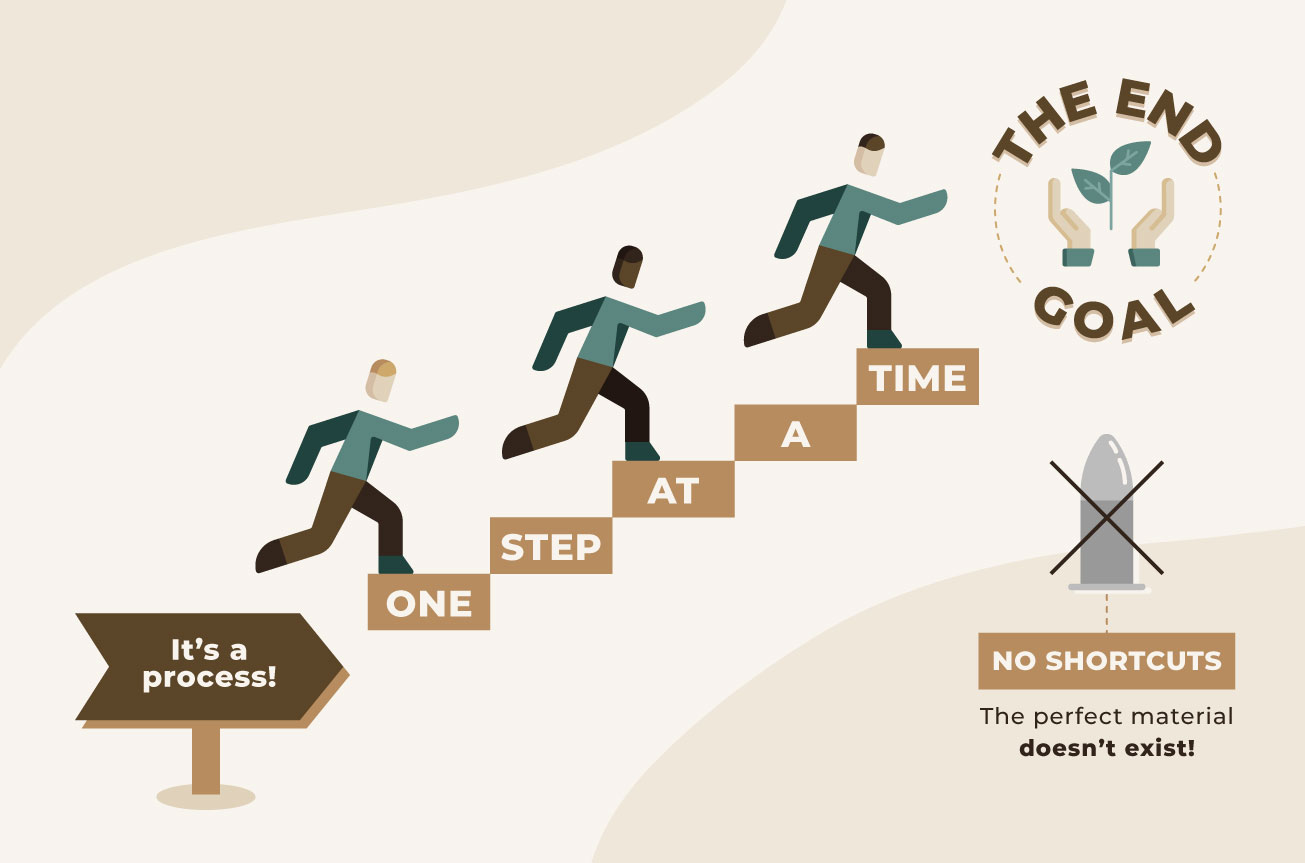
When it comes to choosing packaging materials, it's all about understanding your audience and what they value. As a business owner, you need to weigh the pros and cons of each material, and make a decision based on what will work best for you and your customers.
Final words and our commitments
In conclusion, when it comes to choosing the right packaging for your ecommerce business, there are a few key factors to consider including the financial and logistical aspects, the environmental impact, and the manufacturer's perspective. Plastic packaging is the cheapest and most appealing to small shop owners who are just starting out on a budget.
Compostable packaging is a great option, but they are not for everyone. They're expensive so not everyone can afford them, and the short shelf-life is an issue for businesses who don't move their inventory quickly enough.
To us, biodegradable packaging is the middle ground at this point, because they have longer shelf-life and they are cheaper than compostable packaging.
We strongly believe that no one choice is all bad or all perfect, and that the space is still relatively young. What we learn today might not be relevant tomorrow (or even totally incorrect). Since we are selling biodegradable packaging, let’s imagine the worst case scenario: If biodegradable plastics does not fully break down and remain as microplastics, what would happen then?
- It would still be recyclable just like ordinary flexible plastics at recycling centers.
- Our efforts to raise awareness to people that they are not curb-side recyclable and to encourage them to bring the packaging to recycling centers would continue to have an effect.
- If they do escape the recycling process, they will still break down and not remain intact, killing marine life or any animals that digest them by blocking their airway or digestive system.
That is why at Impack, after considering all of the above and taking into account the perspectives of the manufacturers, brand owners and their customers, we came to make two decisions:
- We decided to make our mailer bags using biodegradable mailers because it is a balance between cost, ease of disposal, and sustainability for our customers (the business owners) and their customers (people who support those businesses).
- We agreed to raise awareness around the subject of recycling single use packaging waste, so that people are aware of the real scope of the issue, as well as the necessary steps each of them can take to address them.
If bioplastics end up in landfills, as many do, without enough oxygen to break them down, they can last for centuries and release methane, a potent greenhouse gas. If thrown into the environment, they post similar threats to PET plastic.
From the Yale School of Environment
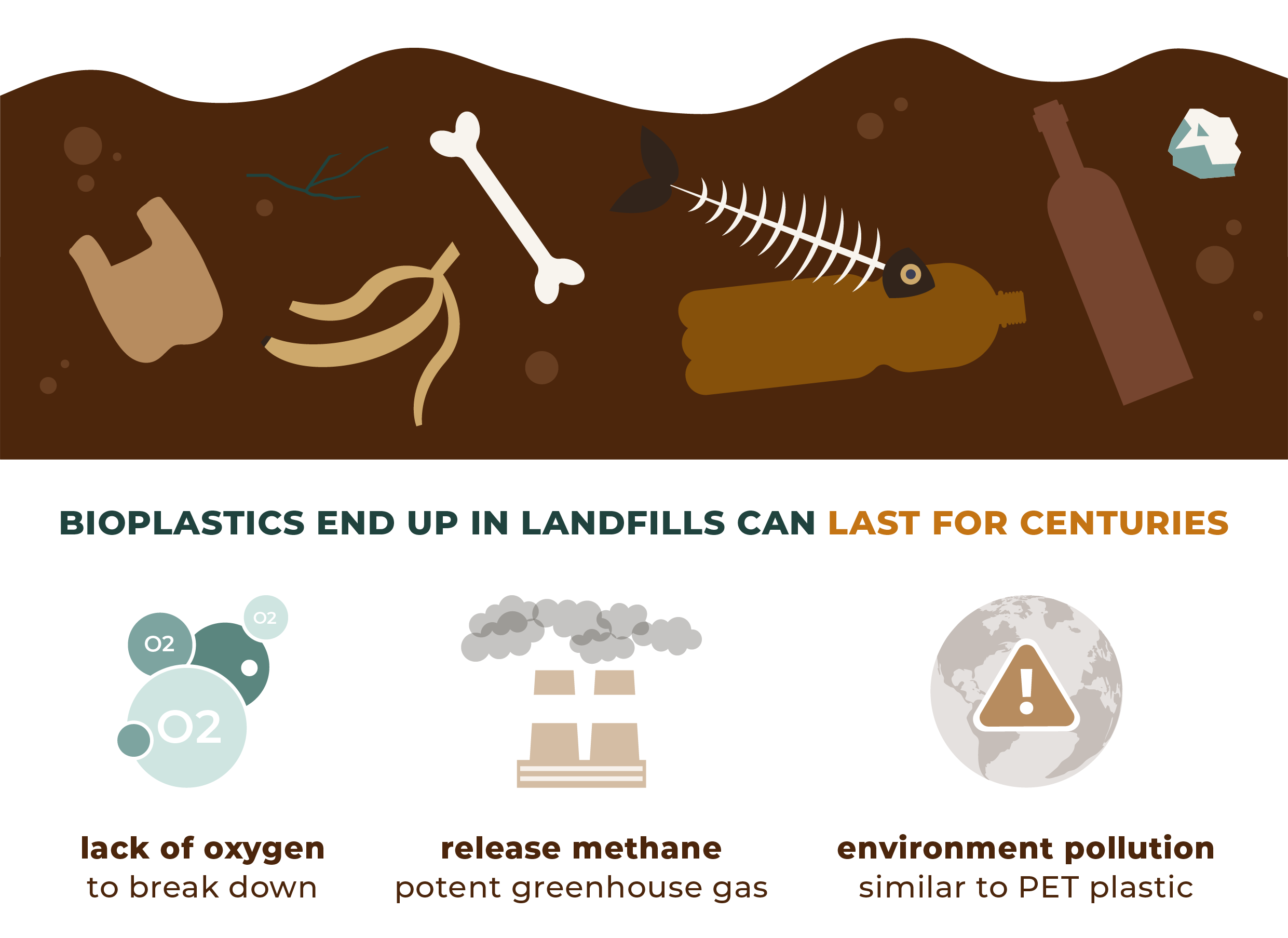
We are all learning as this space is growing and it's important to understand our choices and set the right expectations. Ultimately, it's about understanding our goals and aligning them with our audience to make sure whatever packaging options we use, they get disposed of properly as often as possible. It's about taking small steps towards sustainability, as we all work together to create a better future.
Note: While our current material of choice is d2w, it doesn’t mean that we will only be using that forever for our mailers. We are also actively looking into other materials and packaging options as well, and we have plans to visit our manufacturer and a number of others throughout Asia this summer.
The reason is that while we still strongly believe that d2w mailers are a great option, the landscape & technology change quickly, so we try to be open to new & better options whenever anything becomes available, such as this biodegradable plastics which would break down in a matter of days.
